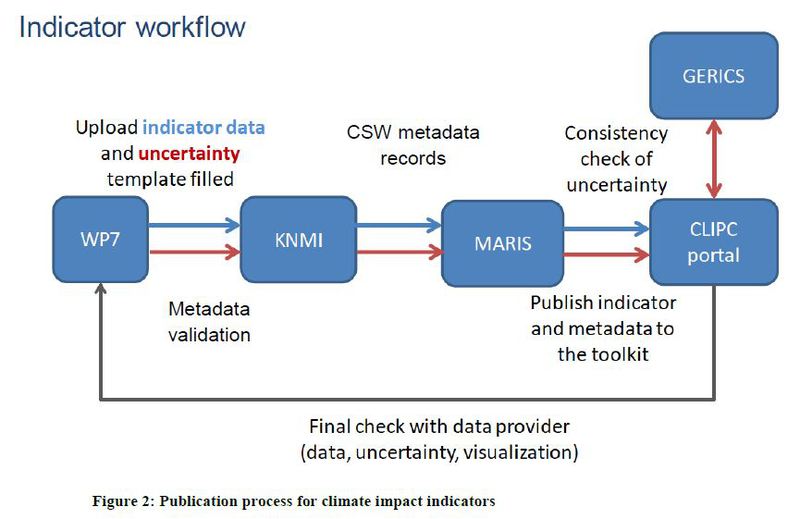D5.3 Publication of project datasets
This deliverable describes and demonstrates the publication status of the climate impactclimate impact
See Impact Assessment indicators published to the CLIPC portal. Within the CLIPC project, climate impact indicators are produced, and are made available to users through the CLIPC portal. A publication status table shows that on the 28th July 2016 55% of indicators have been created. All indicators are due to be available on the CLIPC portal by the end of August 2016.
Using the metadatametadata
Information about meteorological and climatological data concerning how and when they were measured, their quality, known problems and other characteristics. standards developed for climate impact indicators within CLIPC, metadata for the indicators have been created and validated. The indicators are stored at KNMI, are harvested by MARIS and published in the portal. Much of the functionality of the portal has been completed and is demonstrated in this document through screenshots of example searches in the portal. In addition to the climate impact indicators, associated uncertaintyuncertainty
Lack of precision or unpredictability of the exact value at a given moment in time. It does not usually imply lack of knowledge. Often, the future state of a process may not be predictable, such as a roll with dice, but the probability of finding it in a certain state may be well known (the probability of rolling a six is 1/6, and flipping tails with a coin is 1/2). In climate science, the dice may be loaded, and we may refer to uncertainties even with perfect knowledge of the odds. Uncertainties can be modelled statistically in terms of pdfs, extreme value theory and stochastic time series models. information are made available and are demonstrated in this document. The “compare” and “combine” functionality of the portal’s impact indicator toolkit are also shown through screenshots.
As a result of the development of the climate impact indicator metadata standards the bias-corrected climate impact indicator data produced within CLIPC (supported by the Bias-correctionBias-correction
(or ‘bias-adjustment’) - methods to ‘calibrate’ model simulations to ensure their statistical properties are similar to those of the corresponding observed values.
Intercomparison Project) has been accepted by CORDEXCORDEX
Coordinated Regional Climate Downscaling Experiment and is now available through the WCRPWCRP
World Climate Research Programme CORDEX website1,2. These data can now be published through the Earth System Grid Federation3 (ESGF) for wider dissemination. Additionally, the metadata standards developed in CLIPC are already being used in other international projects.
Much progress has been made in the publication of climate impact indicator data since the publication of the CLIPC metadata guidelines. These ensure consistency across multiple institutions producing different types of impact indicators, facilitating the discovery of data on the portal and more widely.
Download the deliverable here.
1 http://www.cordex.org/
2 http://is-enes-data.github.io/CORDEX_adjust_drs.pdf
3 http://esgf.llnl.gov/